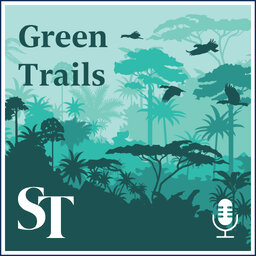Visit to Punggol: How human-wildlife conflict can be mitigated
While Singapore is transforming into a City in Nature, natural habitats have been lost to development, leading to more human and animal clashes. How can wildlife and humans live in harmony?
Synopsis (headphones recommended): Green Trails is a four-part environment podcast special for 2024 where The Straits Times hits the ground with experts.
In this fourth episode, our trails won’t be entirely green. Instead of a nature park or a green space, we head over to an urban place surrounded by buildings and construction noise.
The new neighbourhood of Punggol Northshore recently saw some monkey business, with troops of long-tailed macaques spotted at construction sites and even eating at a void deck of an HDB block.
To find out how residents can responsibly live in a macaque hotspot, ST journalist Shabana Begum speaks with co-chief executive of Animal Concerns Research and Education Society (Acres) Anbarasi Boopal, and president of the Jane Goodall Institute (Singapore) Andie Ang.
Strolling along Punggol Settlement and the promenade opposite Coney Island, the conversation turns to other wildlife in our midst – from the common palm civets that tend to sneak into private houses, to the ever-present junglefowls.
Animals in urban areas being culled is never a clear-cut decision, as Ms Anbarasi says: “Removal (of animals) is always not a solution. And where do we draw the line, right?
“We are okay with hornbills, but we're not okay with other birds.”
Highlights (click/tap above):
2:10 Why is Punggol a monkey hotspot?
4:45 Monkey see, monkey don’t do
11:08 When otters and civets visit homes
14:30 Is culling the best way to reduce bird numbers?
17:08 What to do when you encounter a snake
Read ST’s previous commentary about co-existing with wildlife: https://str.sg/tYpq
Find out more about macaques in Punggol: https://str.sg/ephc
Listen to other Green Trails episodes:
Ep 1: Visit to Sungei Buloh: How Singapore can better host migratory birds - https://str.sg/BrqS
Ep 2: Visit to East Coast: How reclamation will shape up against rising sea levels - https://str.sg/mRG8
Ep 3: Visit to Windsor Park: Can insects in SG's backyard be foraged? - https://str.sg/4V6nQ
Host: Shabana Begum (nshab@sph.com.sg)
Trail producers: Hadyu Rahim, Fa‘izah Sani, Amirul Karim & Elsa Goh
Edited by: Hadyu Rahim
Executive Producers: Lynda Hong (lyndahong@sph.com.sg), Ernest Luis (ernest@sph.com.sg) & Audrey Tan (audreyt@sph.com.sg)
Follow Green Pulse Podcast here and get notified for new episode drops:
Channel: https://str.sg/JWaf
Apple Podcasts: https://str.sg/JWaY
Spotify: https://str.sg/JWag
Feedback to: podcast@sph.com.sg
---
Follow more ST podcast channels:
All-in-one ST Podcasts channel: https://str.sg/wvz7
ST Podcast website: http://str.sg/stpodcasts
ST Podcasts YouTube: https://str.sg/4Vwsa
---
Get The Straits Times' app, which has a dedicated podcast player section:
The App Store: https://str.sg/icyB
Google Play: https://str.sg/icyX
---
#greenpulse #greentrails
 Green Pulse
Green Pulse




